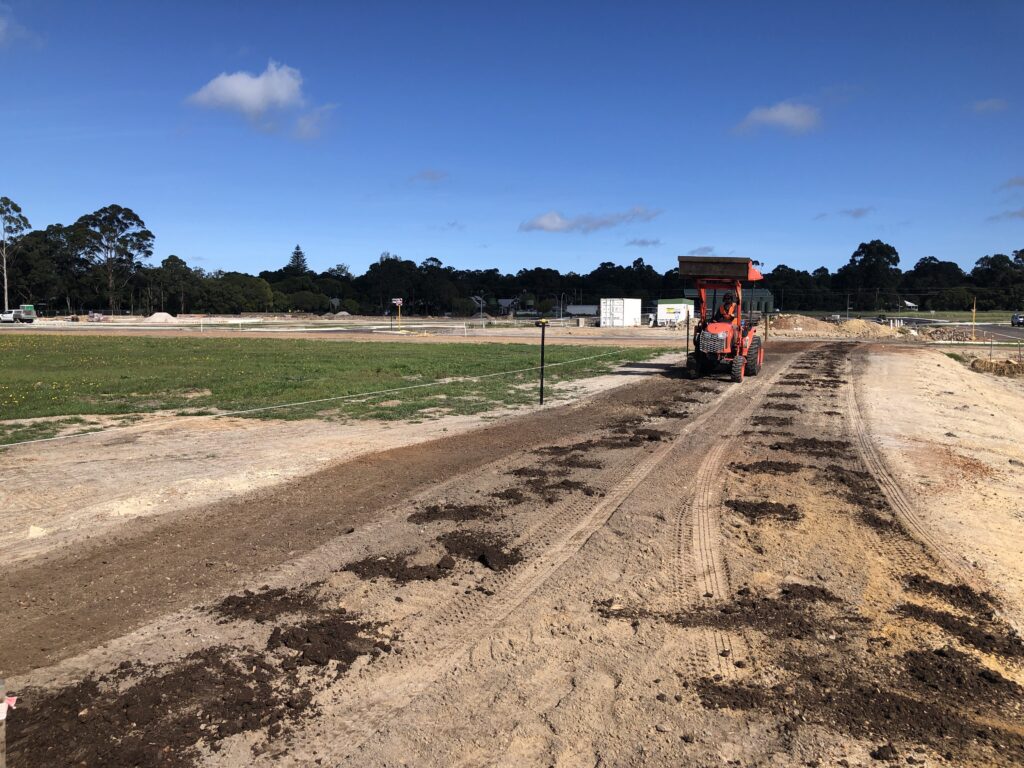Garden soil preparation begins in Stages 1-2
I’m happy to say that initial preparation on the exclusive use areas (EUAs) and community gardens is underway. This is where the soil testing and methodologies that we have been successfully undertaking in the Ecovillage demonstration garden come together to (eventually) bear fruit for the community. The Ecovillage horticultural team of Ethan Cuevas, Paul Jurejevich, Will Roscoe and me (Mark Tupman) are now implementing these same proven strategies and activities throughout Stages 1-2 of the Ecovillage.
Firstly, we have lightly spread a mix of mineral amendments tailored to our soil type, followed by a thin layer of some well-aged compost, which was made at the Ecovillage a couple of seasons ago. As I write, this is being rotary hoed into the soil, removing weeds at the same time and softening the ground for the planting of a cool season multi species cover crop.
Next, we will mix some of our Johnson-Su compost with water and strain it through some mesh to make a compost extract, which will be used to lightly coat the seed. A good compost extract contains a diverse population of beneficial micro-organisms that release bio-chemical signals known to trigger root growth and exudation, encouraging microbe colonisation around the roots. This is shown in young seedlings that develop rhizo-sheaths, or as many folk like to call them, (with a rasta accent) dreadlock roots! When you see these, you know the whole plant, microbe and soil system is off to a rocking good start.
When a diverse community of plants grow, it sends a broad spectrum of energy rich exudes out through its roots (and associated mycorrhizal hyphae) to fuel a diverse community of microbes in the soil surrounds.
In return these microbes acquire and share nutrients, create sticky aggregates that are the very definition of good soil structure and carry out all sorts of other beneficial services.
As soil gets built below the surface, what we see above ground is a healthy stand of plants that smothers the weeds, attracts birds and insects and provides us with plenty of matter with which to compost, use as mulch or feed animals at the end of the season.
This will see us through to spring in readiness for the creation of your residential gardens.
The Autumn Frenzy
Without a doubt, autumn is the busiest time in an annual vegetable garden.
There is always a bit of a crossover between the warm and cool season in a mediterranean climate and this traditionally involves harvesting, processing, pickling, drying, sorting and storing the last of the summer bounty while simultaneously preparing for and planting the first crops of autumn. One almost celebrates the end of green beans as they clear the bed to make way for some broccoli seedlings.
The list of vegetables to plant at this time of year is extensive and includes carrots, peas, lettuce, spinach, spring onions, leeks, beetroot, parsnips, broccoli, cabbage, kale, cauliflower, brussel sprouts, turnip, swedes, fennel, celery, radish, rocket, coriander, dill, garlic etc… and we haven’t even really started on the flowers and herbs yet.
Many of these are delicate crops, started from small seeds so a little extra bed preparation, protection and care is required, and the rain is not reliable enough for us to turn our backs on regular watering just yet.
There’s no time to wait as this planting window is all but over by mid May when conditions get too cold and wet, and growth slows right down. Oh, the joys of living seasonally! It’s easy to miss these nuances with the year round supply we get from the supermarket shelves these days. So why do us gardeners do it? For one thing it keeps life interesting but there’s plenty to be said for produce that doesn’t have to be transported from miles away, cold stored, packaged, preserved and so on. Aside from the obvious environmental benefits it just tastes so much better.
Have you ever had a candy carrot before? What’s a candy carrot? Well! If you plant carrots in early autumn, there’s still enough warm weather for them to grow quickly, put out lots of leaf and accumulate a good amount of sugar. When the first real cold winter snap comes they send much of those sugars to their root in anticipation of the frosty dormant time ahead. Carrots planted at this time of year are as sweet as they get.

